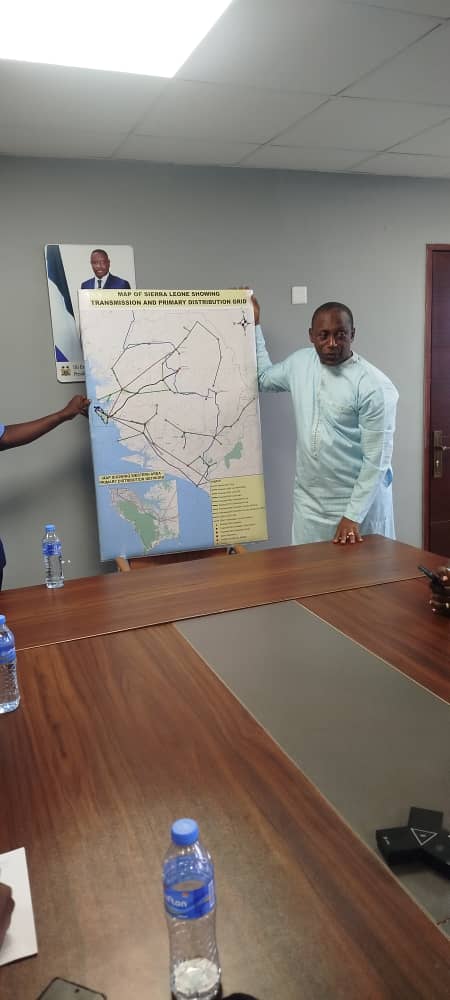
OVER 250MW TO BE ADDED BY 2028
…KKY Surges for Energy Independence
By Ibrahim Alusine Kamara (Kamalo)
In an ambitious energy roadmap that seeks to lift Sierra Leone out of chronic blackouts and crippling electricity shortages, government authorities have announced a sweeping series of reforms and projects that could double the country’s total power generation capacity by the end of 2028—surpassing what has been achieved in the last 60 years.
Speaking in a comprehensive energy sector briefing, senior officials revealed that over 250 megawatts (MW) of new electricity generation could be added within four years, through a combination of local generation, regional imports, renewable energy investments, and strategic infrastructure partnerships.
Short-Term: Replacing Expensive Power with Local Generation
The government says it has already made strides toward replacing expensive emergency sources like Karpowership. A one-year extension—down from previous multi-year deals—was negotiated to give Sierra Leone breathing space to ramp up cheaper alternatives.
Key developments include:
9-10MW from rehabilitated generators at Kingtom.
16MW expected soon from repairs at Black Hall Road.
15–20MW of cheaper imported electricity from Guinea, which recently added capacity through new dams.
36MW of solar energy also in the pipeline at Kingtom.
Combined, these would provide about 52MW of domestic and imported energy by the first quarter of 2026—roughly equal to what was sourced from Karpowership during the power crisis.
Medium-Term: Big Projects, Bigger Targets
By December 2026, Sierra Leone hopes to add over 100MW to the Freetown grid alone. This includes:
50–60MW from a Gas Power Plant in Kissy.
40MW from a proposed hydropower project in Kamakwie.
“This will triple power supply in Freetown,” the official explained, citing the significance of localized generation in urban areas with the highest demand.
Long-Term Vision: A National Transformation
Beyond 2026, the outlook is even more transformative. Key targets by 2028 include:
50MW from Bumbuna II expansion.
50MW from a new solar project in Kono, in partnership with Africa Fifty.
70MW from Phase II of the Gas-to-Power Plant in 2027.
If all goes according to plan, Sierra Leone’s total capacity will jump from 270MW to over 520MW—a historic leap achieved in just four years.
Transmission: The Bottleneck
But officials admit the Achilles’ heel remains transmission.
“For 25 to 30 years, we have had only one transmission line from Bumbuna to Freetown. We are stuck,” the government admitted, calling transmission the “headache” of the sector.
Efforts are underway to secure a new transmission partner, with hopes pinned on the broader MCC Compact—a newly drafted $2.2 to $2.4 billion plan covering generation, transmission, and distribution through 2030.
The plan has already been presented twice to major stakeholders including the World Bank and the African Development Bank, both of whom have expressed strong support.
Mission 300 and Regional Ambitions
The government is aligning Sierra Leone’s energy strategy with the Mission 300 Plan—a regional initiative with the African Union and ECOWAS to build 300GW of power capacity continent-wide. It promotes infrastructure development, regional trade, and integrated power markets.
“Sierra Leone is strategically located and sits in the heart of a 50 million people market,” the official noted, referencing the country’s proximity to energy-hungry neighbors like Guinea, Liberia, and Côte d’Ivoire.
Meters, Demand, and the Growing Pains
One of the key short-term challenges is demand management. With over 40,000 homes being connected with prepaid meters, electricity demand is surging faster than supply can keep up—resulting in voltage drops and outages.
“This is why the short-term plan is so crucial. The moment we connect more meters, more demand comes in—and trouble begins,” the government admitted.
Legacy and the Path Ahead
The official concluded with a pointed comparison: in 60 years, Sierra Leone added just 270MW of power. In the next four years, the current administration hopes to double that.
“We are leaving not just projects but a clear energy masterplan—defended, supported, and funded. By 2028, Sierra Leone could even begin exporting electricity.”
The ambitious vision rests on effective implementation, accountability, and continued investor confidence—but for the first time in decades, the country appears to be moving toward an energy-secure future.